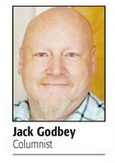During solar eclipse, you can be a citizen scientist
Published 6:49 am Monday, August 14, 2017
The solar eclipse is coming, but I’m sure you already knew that. It seems like everyone is talking about it, and it’s going to be a pretty big deal.
Everyone in the United States will be able to see at least some degree of a partial eclipse. I for one am very excited about the eclipse, because I’ve never seen a solar eclipse before. Even though totality only lasts for about two minutes, I’ve been looking forward to the eclipse for months.
I’ll be traveling to see the totality because here in central Kentucky, we will not see a total solar eclipse. During any part of the eclipse except totality — when the sun is completely blocked by the moon — it’s very important to wear eclipse glasses the whole time you look at the sun in order to protect your eyes.
Just in case you aren’t familiar with the coming eclipse, here are the basics. On Monday, Aug. 21, here in central Kentucky, the moon will start to cover up the sun at about 1:02 p.m. and will obscure about 96.6 percent of the sun at 2:30 p.m. This will be the peak of the eclipse in the Danville area. Then the moon will slowly begin to move away from the sun, until it is no longer covering any of the sun at about 3:55 p.m.
If you visit the Vox website — bit.ly/CentralKYEclipse — and type in your zip code, you can see a really cool video illustration depicting what the eclipse will look like for your area. The website also has other videos showing the path of totality and explaining why eclipses happen. While we won’t have totality here in central Kentucky we will still have quite a bit of the sun obscured by the moon.
While you are viewing the eclipse, you have an opportunity to serve as a citizen scientist. NASA is inviting people around the country to record some data while they are viewing the eclipse. In particular, they are interested in cloud, air and temperature data.
GLOBE, which stands for Global Learning and Observations to Benefit the Environment, is a “NASA-supported research and education program that encourages students and citizen scientists to collect and analyze environmental observations,” according to the NASA website. If you download the GLOBE Observer on your smartphone you can register and then begin making observations.
If you are interested in making observations during the eclipse, I would recommend downloading the app and creating your free account prior to the eclipse. That way, you aren’t wasting time fiddling too much on your phone when you could be enjoying the eclipse.
It seems that the only equipment you need to make observations during the eclipse is a thermometer for temperature; everything else is just what you can observe. It’s really interesting because during a solar eclipse, the temperature drops because the sun’s rays aren’t reaching the earth to warm it up. It’ll be interesting to make some observations and be a scientist during the eclipse.
I hope everyone enjoys themselves and can view the eclipse safely.






